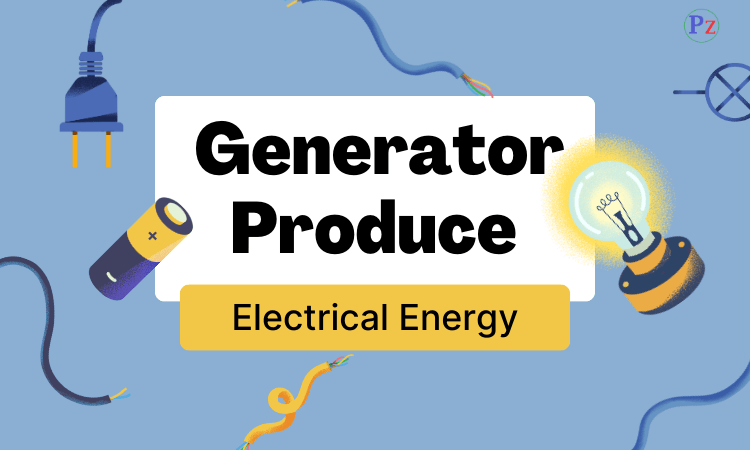Generators are fascinating devices that play a crucial role in our everyday lives, providing electricity when we need it most. From powering homes during outages to supporting industries in remote areas, generators are indispensable. But how exactly do they work? Let’s dive into the science behind how a generator produces electrical energy.

[sc_fs_faq html=”true” headline=”h2″ img=”” question=”What is Electrical Energy?” img_alt=”” css_class=””] Electrical energy is the power generated by the movement of electrons through a conductor, like a wire. It comes in two primary forms: Alternating Current (AC) and Direct Current (DC). AC electricity, the type you find in your home sockets, changes direction periodically, whereas DC electricity flows in one constant direction and is commonly found in batteries. [/sc_fs_faq]
What is a Generator?
A generator is a machine that converts mechanical energy into electrical energy. The basic principle behind a generator’s operation is electromagnetic induction, a phenomenon discovered by Michael Faraday in 1831. Faraday found that when a conductor moves in a magnetic field, it generates an electric current. This principle is the foundation of all modern generators.
The Science Behind Generators: Electromagnetic Induction
Electromagnetic induction is the heart of how generators work. According to Faraday’s law, a change in the magnetic environment of a coil of wire will induce an electromotive force (EMF) or voltage in the coil. Generators use this principle by rotating a coil in a magnetic field, which induces a flow of electric current.
Main Components of a Generator
Understanding how a generator works means getting familiar with its key components:
- Rotor and Stator: The rotor is the rotating part, and the stator is the stationary part of the generator. The rotor generates a moving magnetic field around the stator, which produces electricity.
- Armature: The armature is the coil where the electricity is generated. It interacts with the magnetic field created by the rotor to induce an electric current.
- Commutator: This component is responsible for converting the alternating current (AC) induced in the armature into direct current (DC).
- Field Windings and Brushes: The field windings create the magnetic field, while brushes help transfer the current to the external circuit.
- Voltage Regulator: This part ensures the voltage output remains consistent, adjusting for any fluctuations.
Types of Generators
There are two main types of generators: AC Generators (Alternators) and DC Generators.
- AC Generators: These generate alternating current and are widely used for residential and commercial power supply. Alternators are highly efficient and suitable for transmitting power over long distances.
- DC Generators: These generate direct current and are used in applications where a stable and continuous voltage is required, like battery charging and electroplating.
How Does a Generator Work? Step-by-Step Process
To understand the operation of a generator, let’s break it down step-by-step:
- Mechanical Energy Input: A source of mechanical energy, like a diesel engine or wind turbine, spins the generator’s rotor.
- Magnetic Field Interaction: As the rotor spins, it creates a moving magnetic field.
- Electromagnetic Induction: The spinning rotor induces an electromotive force (EMF) in the stator windings, producing an electric current.
- Electricity Output: The generated electricity is then sent through a voltage regulator to ensure it is safe and stable before being distributed to homes, businesses, or stored in batteries.
Fuel Sources for Generators
Generators can run on various fuel types:
- Diesel Generators: Known for their durability and efficiency, but they can be noisy and produce emissions.
- Gasoline Generators: Common for small-scale applications but less efficient and have a shorter lifespan than diesel.
- Natural Gas Generators: Cleaner than diesel and gasoline, suitable for both large and small applications.
- Renewable Energy Generators: Wind, hydro, and solar power can also be harnessed to produce electricity using generator technology.
The Role of Generators in Different Sectors
Generators are essential in various sectors:
- Residential Uses: Provide backup power during outages.
- Industrial Applications: Ensure continuous power supply in factories and construction sites.
- Emergency Services and Backup Power: Crucial for hospitals and emergency services.
- Recreational Uses: Used in camping, RVs, and outdoor events.
Advantages and Disadvantages of Using Generators
Advantages:
- Reliable power supply
- Wide range of applications
- Can be mobile or stationary
Disadvantages:
- Can be noisy
- Potential for pollution
- Requires regular maintenance
Maintaining a Generator
Regular maintenance ensures a generator’s longevity and efficiency. This includes checking oil levels, cleaning filters, inspecting for leaks, and ensuring the battery is charged. Addressing common issues like overheating or engine stalling is crucial for uninterrupted power.
Environmental Impact of Generators
Generators, especially those running on fossil fuels, can produce emissions that contribute to air pollution and climate change. However, newer models and innovations are focusing on reducing emissions and improving fuel efficiency. Solar-powered and wind-powered generators offer more sustainable alternatives.
Future of Generators: Trends and Innovations
The future of generators is leaning towards more sustainable and technologically advanced solutions. Smart generators that integrate with renewable energy sources and IoT devices are becoming increasingly popular, allowing for more efficient energy management.
Safety Tips for Using Generators
When using a generator, safety should always come first:
- Operate generators outdoors in well-ventilated areas.
- Keep them dry and avoid using them in wet conditions.
- Never refuel a running or hot generator.
- Use proper cords and never back-feed power into your home.
| Read More Topics |
| Hydro-electric power plant-Classification |
| Main classification of signals |
| Primary sources of electric power |





